Cybersecurity Risk Analysis of Electric Vehicles Charging Stations
Abstract
1. Introduction
- (1)
- The potential cyber vulnerabilities in EVs charging ecosystem are identified, which could be linked to potential threats.
- (2)
- It exploits some of the coexisting cybersecurity attacks and their possible use in EV charging networks.
- (3)
- The literature on security issues in EV charging is explored, thoroughly focusing on cyber-attack points and vulnerable communication protocols.
- (4)
- A critical cyber threat analysis of EV charging sessions is done based on real-time charging data and parameters. This analysis can be linked to cyber risks in EV charging networks.
- (5)
- Open cyber research issues have been precisely highlighted in the EV charging ecosystem as new knowledge for domain researchers.
2. Background
2.1. Advancement in EV Ecosystem
2.2. EV Adaption Trend
- Level 1 charging uses a standard household outlet (120 volts) and provides a slow charge rate of around 2–5 miles of range per hour of charging [13]. This type of charging is best suited for overnight charging at home and is convenient for EV owners with low daily driving needs.
- Level 2 charging uses a dedicated charging station that operates on 240 volts and provides a faster charge rate of 10–60 miles of range per hour of charging, depending on the vehicle and the charging station’s power output [13]. Level 2 charging is commonly found in public locations such as shopping centers, workplaces, and public parking facilities, and it is suitable for daily charging needs.
- DC fast charging (DCFC) is the fastest type of EV charging. It can provide up to 80% of a vehicle’s battery capacity in around 30 min, depending on the vehicle and the charging station’s power output [14]. DCFC stations are typically located along highways and major travel routes, making them ideal for long-distance travel.
2.3. EV Charging Use Case
- (1)
- More convenient: Installing a home charging station presents benefits in terms of saved time and reduced reliance on gasoline. Charging an electric vehicle at home can eliminate waiting in parking areas for charging opportunities.
- (2)
- Increased savings: According to U.S. Department of Energy estimates, charging an EV with a 33 kWh capacity at 0.13 cents per kWh costs only $0.04 per mile [15]. Home charging saves money by avoiding high public charging rates. Residential EV charging stations pay for themselves via cost savings.
- (3)
- Greater home value: EVCSs could increase property value and save time/costs. Homebuyers with EVs seek residences with pre-installed EV charging, boosting demand. This setup could lead to faster sales at higher prices, recouping the initial EVCS investment.
- (4)
- Less wear and tear and safe: Fewer people use it, which reduces wear and tear and repair costs. We know who uses the chargers despite not being connected to any external network.
- (5)
- Longer charging time: Many owners wish to keep the Level 1 charger with their EVs. These chargers charge slower than public ones. A Level 2 charger helps speed up charging. Level 2 chargers are faster than Level 1 chargers, charging batteries up to 30–44 miles per hour [15].
- (6)
- Higher Upfront Cost: If they do not have the money to pay for their own, they will have to rely on public stations. In contrast, individuals with the money to do so will gain long-term savings and increased property value by charging at home.
- (1)
- Using public EV charging instead of home infrastructure has the following advantages and some associated challenges:
- (2)
- Less investment cost: Public EV charging stations do not require substantial initial expenditure. Since the company paid for and built the station, individuals only need to pay for the electricity they use for charging their EVs.
- (3)
- Economical for the public: Public EVCSs may offer faster charging than most homes can afford. Some public chargers are ideal for needing to charge a vehicle urgently during a journey.
- (4)
- Longer public waiting time: When a person arrives at a charging station, they may have to wait a long time. Thus, home charging can be preferred over public charging to minimize long delays.
- (5)
- Inconvenient searching for EVCSs: Finding one may be difficult if someone is unfamiliar with their neighborhood’s charging stations. Even if a person has discovered all the public charging stations on their normal route, having an at-home charger is a smart choice.
- (6)
- Potential damage to battery: Utilizing Level 3 fast chargers may cause an EV’s battery to deteriorate more quickly than with Level 1 or Level 2 chargers [15]. For those who want to increase their battery life, it is advisable to use rapid charging stations rarely and home chargers frequently.
2.4. EV Charging Usage Pattern
3. Cyber Vulnerability in EVCS
3.1. Infrastructure Centric Vulnerability in EVCS
- EV connectors: EV connectors serve as potential targets for attackers due to their communication protocols and connectivity capabilities. Attackers may exploit these vulnerabilities to introduce malware or manipulate charging settings, gaining unauthorized access to the EVCS. This exploitation can have severe security implications, as malicious actors’ unauthorized access to the EVCS opens the door for further compromise and control. Moreover, side-channel threats pose a significant concern during the charging process.
- 2.
- User terminals: Public EV charging stations commonly rely on authentication methods such as RFID, NFC, or credit card chips/swipes to connect charging sessions and user accounts, facilitating billing and tracking. However, the security of these authentication systems is crucial, as any compromise could lead to significant consequences for both users and the charging infrastructure.
- 3.
- Internet connections: Integrating Internet connections in modern EVCSs brings convenience and advanced services operators, or EVCS providers offer. Nevertheless, it is essential to acknowledge the associated security risks that arise from this connectivity. Breaching the EVCSs compromises the charging infrastructure and allows attackers to exploit the system as an access point for launching broader attacks on critical infrastructure.
- 4.
- Maintenance terminals: EVCSs typically comprise multiple circuit boards communicating through the Ethernet or serial or analog interfaces [18]. One significant concern is the lack of encryption in module communications, which leaves these communications vulnerable to eavesdropping or tampering by unauthorized individuals. Additionally, the presence of physical ports intended for maintenance purposes can inadvertently create potential access points for attackers if overlooked during production or not properly secured.
3.2. Difference in Threats of EV Network and Classical Network
- Unique Communication Protocols: EVs rely on specialized communication protocols for vehicle-to-vehicle (V2V) or vehicle-to-infrastructure (V2I) communication. These protocols introduce novel vulnerabilities and attack vectors distinct from those in traditional network security. Implementing these protocols requires careful consideration to ensure secure and reliable communication within the EV ecosystem.
- Physical and Cyber Integration: Integrating physical components (such as batteries and charging stations) with cyber systems (including in-vehicle software and charging infrastructure networks) creates a complex interplay between the physical and digital realms. Security breaches in either component can have far-reaching consequences, impacting the overall safety and functionality of the EV system. Protecting against such threats requires a comprehensive approach encompassing both physical and cybersecurity measures.
- Battery Security: The security of EV batteries is paramount, as they serve as the primary energy source. Unauthorized access or manipulating battery systems can lead to severe safety risks, such as fire incidents or compromised vehicle performance. Robust security measures must be in place to safeguard EV batteries from unauthorized access, tampering, or malicious attacks.
- Charging Infrastructure: EVs heavily rely on charging infrastructure, which presents its own set of security concerns. Securing charging stations is essential to prevent unauthorized access to billing systems, ensure the integrity of transactions, and protect against potential attacks on the power grid. The interconnected nature of charging infrastructure necessitates robust security mechanisms to maintain the reliability and trustworthiness of the charging process.
- Privacy Concerns: EVs gather and process sensitive driving behavior, location, and energy consumption data. Protecting the privacy of these data poses unique challenges beyond classical network security considerations. Safeguarding personal information from unauthorized access and ensuring responsible data handling practices are vital to address privacy concerns in the EV ecosystem.
3.3. Protocol-Centric Vulnerabilities in EVCS
- (1)
- The Signal-Level Attenuation Characterization protocol supports mutual authentication and encrypted communication, allowing it to function securely.
- (2)
- Even though this protocol is Transport Layer Security compliant, encryption is turned off after an external authority verifies the charging session as safe.
- (3)
- ISO 15118 also facilitates the establishment of public key infrastructure.
3.4. Cybersecurity Attacks in EVs
- (1)
- False Data Injection: False data injection in an EVCS involves an attacker gaining unauthorized access to the communication channels within the system. By exploiting vulnerabilities in the communication protocols, the attacker intercepts data transmission between the EVSEs, smart measuring equipment, and the SCMS. They then manipulate or inject false data related to PEV charging and discharging, such as altering charging rates or battery status [19]. This exploitation can deceive the SCMS, leading to incorrect decision-making and potentially harmful consequences. The impact includes overcharging batteries, compromised vehicle performance, and disruptions to grid stability. Preventive measures such as secure communication protocols, encryption, and authentication mechanisms are necessary to mitigate this attack and ensure the integrity of charging data in the EVCS.
- (2)
- Man-in-the-Middle: In an EVCS, a Man-in-the-Middle (MITM) attack occurs when an unauthorized attacker inserts themselves between the communication channels of the system. The attacker intercepts and manipulates the data transmission between the Electric Vehicle Supply Equipment (EVSE), the Plug-in Electric Vehicles (PEVs), and the Smart Charging Management System (SCMS) [27]. By gaining access to the communication flow, the attacker can alter, discard, or misrepresent the data exchanged, leading to various malicious outcomes [4]. For instance, the attacker can tamper with charging requests, leading to overcharging or over-discharging PEV batteries, potentially damaging or reducing their range [4]. Additionally, the attacker can exploit this position to breach privacy by accessing sensitive information exchanged between the PEVs and the SCMS. To mitigate MITM attacks in the EVCS, robust encryption, authentication mechanisms, and secure communication protocols should be implemented to ensure the integrity and confidentiality of the data transmission [31].
- (3)
- Denial of Service: In an EVCS, a Denial-of-Service (DoS) attack aims to disrupt the system’s normal functioning by overwhelming it with excessive traffic or requests [32]. In this attack, an adversary targets the SCMS or associated components to overload the network, making it unable to provide services to legitimate users. The attacker may flood the system with high charging requests, exhaust system resources, or exploit vulnerabilities to crash the SCMS. As a result, the system may become unresponsive, preventing PEVs from accessing the charging services. Such an attack can have severe consequences, particularly for critical emergency vehicles that require charging, potentially compromising their availability and hindering emergency response efforts [33]. To counter DoS attacks in EVCS measures such as traffic filtering, rate limiting, and anomaly detection techniques can be implemented to identify and mitigate abnormal traffic patterns, ensuring uninterrupted and reliable charging services for PEVs [34].
- (4)
- Malware Injections: In an EVCS, the Malware Injection attack involves introducing malicious software into the system, mainly targeting the EVSE units. Since EVSEs are often publicly accessible at charging stations, they can become vulnerable to malware infections. Attackers can exploit these vulnerabilities to inject malware into EVSEs, which can then spread to other units within the network. Once infected, the malware can compromise the security of the entire EVCS ecosystem, including the PEVs, the SCMS, and even the power grids. This attack can result in the theft of sensitive data, such as credit card information and personal details, from unsuspecting users [31]. Implementing robust cybersecurity measures to mitigate Malware Injection attacks, including regular security testing and assessment of EVSEs, is crucial to ensure their integrity and protect the overall EVCS infrastructure from potential malware threats.
- (5)
- Physical Attack: A physical attack in an EVCS refers to any deliberate act of damaging or tampering with the system’s physical components, such as the EVSE or the PEVs. This type of attack can have severe consequences, including personal safety risks and threats to the integrity of the power grid network [35]. For example, an attacker may physically manipulate the charging infrastructure to disrupt the charging process or cause damage to the electrical system. By compromising the synchronized charging activities, the attacker can create disturbances in the grid’s stability and potentially disrupt the overall functionality of the EVCS. Safeguarding against physical attacks in the EVCS requires implementing physical security measures, such as surveillance systems, access controls, and tamper-resistant designs for the charging equipment, to deter and mitigate potential physical threats.
4. Cyber Threat/Risks Analysis in EVCS
4.1. Charging System Threat Analysis
- The EVs sector needs safer software development practices.
- Communication between EVs and EVCSs is not standardized on a secure communication protocol.
- Insufficient data integrity controls and cybersecurity monitoring systems exist.
- While the physical characteristics of EVCSs vary, many are easily accessible and modifiable.
- (1)
- Physical Attack: Due to its lack of physical protection, EVCSs are vulnerable to attacks that disable the system, steal power, or infect it with malware via accessible USB ports.
- (2)
- Logical Attack: The EVCSs are compromised in such an attack by exploiting a flaw in the firmware, which allows the attacker to acquire logical access to the system. Some suppliers’ firmware upgrades, including those released by Schneider Electric, may be downloaded from the Internet and dissected by attackers to discover security flaws and potential entry points [32]. Kaspersky laboratories could also crack the Charge Point home charger firmware by local attack [40].
- (3)
- Partially controlled Remote Attack: Local Area Networks at charging points may be used by attackers to gain access to the EVCSs. Weak authentication and outdated encryption methods are typical of such systems. Over the charging line, the EVs and EVCSs communicate via a series of protocols, which leaves the system open to attack.
- (4)
- Fully controlled Remote Attack: Users of EVs interact with the EVs management system through an online user interface. Such interaction opens potential vulnerabilities, whether a website or a mobile application.
4.2. Charging Session Threat Analysis
4.2.1. Experimental Setup
- (1)
- Total energy consumed: Charging sessions that consume significantly more or less energy than usual can be considered abnormal.
- (2)
- Maximum charging power: Charging sessions that consume significantly more or less power than usual can be flagged as abnormal.
- (3)
- Connected time: Charging sessions that take an unusually long time or end abruptly can be flagged as abnormal.
- (4)
- Charging time: Charging sessions that take significantly longer or shorter time than usual can be flagged for further investigation.
- (5)
- UTC transaction start and stop timestamps: Charging sessions that start or end at unusual times can be considered abnormal.
- (6)
- Energy interval: Charging sessions with an unusual energy interval between two consecutive energy measurements can be flagged for further investigation.
- (7)
- Average power: Charging sessions that consume significantly more or less power on average than usual can be considered abnormal.
4.2.2. Result and Discussion
5. Open Research Issues in EVCS
- Cyberattacks on EV Charging Networks.
- Lack of Standardization in EV Charging Networks.
- Insecure End-to-End Communication for EVs Charging
- Define-Test-Validate Charging Security Guidelines
- AI-enabled EV Charging
6. Conclusions
Author Contributions
Funding
Institutional Review Board Statement
Informed Consent Statement
Data Availability Statement
Acknowledgments
Conflicts of Interest
References
- The UK Govt Strategy. “Road to Zero” by 2050. Available online: https://assets.publishing.service.gov.uk/government/uploads/system/uploads/attachment_data/file/739460/road-to-zero.pdf (accessed on 21 January 2023).
- IEA. Global EV Outlook 2020. Available online: https://www.iea.org/reports/global-ev-outlook-2020 (accessed on 22 January 2023).
- Committee on Climate Change’s (CCC). Net Zero: The UK’s Contribution to Stopping Global Warming, May 2019; p. 34. Available online: https://www.theccc.org.uk/wp-content/uploads/2019/05/Net-Zero-The-UKs-contribution-to-stopping-global-warming.pdf (accessed on 22 January 2023).
- Sayed, M.A.; Atallah, R.; Assi, C.; Debbabi, M. Electric vehicle attack impact on power grid operation. Int. J. Electr. Power Energy Syst. 2022, 137, 107784. [Google Scholar] [CrossRef]
- Kaspersky. Remotely Controlled EV Home Chargers—The Threats and Vulnerabilities. 2018. Available online: https://securelist.com/remotely-controlled-ev-home-chargers-the-threats-and-vulnerabilities/89251/ (accessed on 11 March 2023).
- Schneider Electric EVLink Parking. 2018. Available online: https://us-cert.cisa.gov/ics/advisories/ICSA-19-031-01 (accessed on 2 March 2023).
- Rangarajan, S.S.; Sunddararaj, S.P.; Sudhakar, A.V.V.; Shiva, C.K.; Subramaniam, U.; Collins, E.R.; Senjyu, T. Lithium-Ion Batteries—The Crux of Electric Vehicles with Opportunities and Challenges. Clean Technol. 2022, 4, 908–930. Available online: https://www.mdpi.com/2571-8797/4/4/56 (accessed on 4 March 2023). [CrossRef]
- Jayashree, S.; Malarvizhi, K.; Pradeep, R. Impact of Hybrid Electric Vehicle Penetration and Its Challenges on Distribution System. Adv. Nat. Appl. Sci. 2017, 11, 101–109. Available online: http://www.aensiweb.net/AENSIWEB/anas/anas/2017/Special%201/101-108.pdf (accessed on 23 February 2023).
- Nayak, S.; Bohre, A.K. Status of Electric Vehicles Charging Methods. Int. J. Eng. Sci. Technol. 2022, 14, 132–143. Available online: https://www.ajol.info/index.php/ijest/article/view/230840 (accessed on 7 February 2023). [CrossRef]
- Shrivastav, A.V.; Khan, S.S.; Gupta, R.K.; Ekshinge, P.R.; Parmeshwar, N. Electric Vehicle Charging Station (Case Study on the Infrastructure of EV Charging Station). J. Emerg. Technol. Innov. Res. 2020, 7, 2017–2033. Available online: https://www.jetir.org/view?paper=JETIR2004477 (accessed on 11 February 2023).
- Bhattacharjee, S.; Batool, S.; Nandi, C.; Pakdeetrakulwong, U. Investigating Electric Vehicle (EV) Charging Station Locations for Agartala, India. 2017. Available online: https://www.researchgate.net/publication/325144490_Investigating_Electric_Vehicle_EV_Charging_Station_Locations_for_Agartala_India (accessed on 7 March 2023).
- Lee, H.; Alex, C. Charging the Future: Challenges and Opportunities for Electric Vehicle Adoption. 2018. Available online: https://projects.iq.harvard.edu/files/energyconsortium/files/rwp18-026_lee_1.pdf (accessed on 2 April 2023).
- U.S. Department of Energy. Charging Levels and Connector Types. 2021. Available online: https://www.energy.gov/eere/electricvehicles/charging-levels-and-connector-types (accessed on 13 February 2023).
- Alternative Fuels Data Center; U.S. Department of Energy. DC Fast Charging. 2021. Available online: https://afdc.energy.gov/vehicles/electric_dc_fast_charge.html (accessed on 15 February 2023).
- Holzer, S. Public VS. at-Home EV Charging Stations: The Pros and Cons, Bonney. 2022. Available online: https://www.bonney.com/2022/03/the-pros-and-cons-of-public-vs-at-home-ev-charging-stations/#:~:text=A%20public%20charging%20station%20refers,electricity%20bills%20associated%20with%20it (accessed on 29 January 2023).
- Alternative Fuels Data Center; U.S. Department of Energy. U.S. Public and Private Electric Vehicle Charging Infrastructure. 2021. Available online: https://afdc.energy.gov/data/10327 (accessed on 31 January 2023).
- Johnson, J.; Berg, T.; Anderson, B.; Wright, B. Review of Electric Vehicle Charger Cybersecurity Vulnerabilities, Potential Impacts, and Defenses. Energies 2022, 15, 3931. Available online: https://www.mdpi.com/1996-1073/15/11/3931 (accessed on 26 January 2023). [CrossRef]
- Bhusal, N.; Gautam, M.; Benidris, M. Cybersecurity of Electric Vehicle Smart Charging Management Systems. 2020 52nd North American Power Symposium (NAPS). IEEE. 2021. Available online: https://ieeexplore.ieee.org/document/9449758 (accessed on 19 February 2023).
- Alcaraz, C.; Lopez, J.; Wolthusen, S. OCPP Protocol: Security Threats and Challenges. IEEE Trans. Smart Grid 2017, 8, 2452–2459. Available online: https://pure.royalholloway.ac.uk/en/publications/ocpp-protocol-security-threats-and-challenges (accessed on 7 April 2023). [CrossRef]
- IEC TR 61850-90-8:2016; Communication Networks and Systems for Power Utility Automation—Part 90-8: Object Model for E-mobility. Available online: https://webstore.iec.ch/preview/info_iec61850-90-8%7Bed1.0%7Den.pdf (accessed on 22 July 2023).
- IEC 61851-1:2017; Electric Vehicle Conductive Charging System—Part 1: General Requirements. Available online: https://webstore.iec.ch/publication/33644 (accessed on 22 July 2023).
- Open Charge Alliance. Open Charge Point Protocol, Versionen 1.5, 1.6, 2.0. 2014. Available online: https://www.openchargealliance.org (accessed on 22 July 2023).
- ISO 15118; Part 1–8: Road Vehicles—Vehicle to Grid Communication Interface—Part 1: General Information and Use-Case Definition. Available online: https://www.iso.org/standard/69113.html (accessed on 22 July 2023).
- Fu, S.; Zhang, Z.; Jiang, Y.; Chen, J.; Peng, X.; Zhao, W. An Automatic RF-EMF Radiated Immunity Test System for Electricity Meters in Power Monitoring Sensor Networks. Ad Hoc Sens. Wirel. Netw. 2021, 50, 173–192. Available online: http://www.oldcitypublishing.com/wp-content/uploads/2021/12/AHSWNv50n1-4p173-192Fu.pdf (accessed on 15 March 2023).
- Baker, R.; Ivan, M. Losing the Car Keys: Wireless {PHY-Layer} Insecurity in {EV} Charging. 28th USENIX Security Symposium (USENIX Security 19). 2019. Available online: https://www.usenix.org/conference/usenixsecurity19/presentation/baker (accessed on 5 March 2023).
- Hsaini, S.; Ghogho, M.; Charaf, M.E.H. An OCPP-Based Approach for Electric Vehicle Charging Management. Energies 2022, 15, 6735. Available online: https://www.mdpi.com/1996-1073/15/18/6735 (accessed on 13 March 2023). [CrossRef]
- Anderson, B.R.; Jay, B.J. Securing Vehicle Charging Infrastructure; No. SAND2021-5745PE; Sandia National Lab. (SNL-NM): Albuquerque, NM, USA, 2021. Available online: https://www.energy.gov/sites/default/files/2021-06/elt198_johnson_2021_o_5-11_558pm_LR_TM.pdf (accessed on 23 February 2023).
- Basso, T.S.; DeBlasio, R. IEEE 1547 series of standards: Interconnection issues. IEEE Trans. Power Electron. 2004, 19, 1159–1162. [Google Scholar] [CrossRef]
- Poyyamani Sunddararaj, S.; Rangarajan, S.S.; Nallusamy, S.; Collins, E.R.; Senjyu, T. A Brief Survey on Important Interconnection Standards for Photovoltaic Systems and Electric Vehicles. World Electr. Veh. J. 2021, 12, 117. Available online: https://www.mdpi.com/2032-6653/12/3/117 (accessed on 13 February 2023). [CrossRef]
- Foster, J. EVSec Automates Cybersecurity for EV Ecosystem, Electric Vehicle Charging & Infrastructure. 2022. Available online: https://www.evcandi.com/products/evsec-automates-cybersecurity-ev-ecosystem (accessed on 12 February 2023).
- Carter, C.; Onunkwo, I.; Cordeiro, P.; Johnson, J. Cyber Security Assessment of Distributed Energy Resources. In Proceedings of the IEEE 44th Photovoltaic Specialist Conference (PVSC), Washington, DC, USA, 25–30 June 2017; pp. 2135–2140. Available online: https://ieeexplore.ieee.org/document/8366503 (accessed on 23 March 2023). [CrossRef]
- Cyber Assessment Report of Level 2 AC Powered Electric Vehicle Supply Equipment. 2018. Available online: https://avt.inl.gov/sites/default/files/pdf/reports/Level2EVSECyberReport.pdf (accessed on 15 February 2023).
- Phan, T.V.; Park, M. Efficient Distributed Denial-of-Service Attack Defense in SDN-Based Cloud. IEEE Access 2019, 7, 18701–18714. Available online: https://ieeexplore.ieee.org/document/8630919 (accessed on 11 March 2023). [CrossRef]
- Qin, J.; Li, M.; Shi, L.; Yu, X. Optimal Denial-of-Service Attack Scheduling with Energy Constraint over Packet-Dropping Networks. IEEE Trans. Autom. Control. 2017, 63, 1648–1663. Available online: https://www.researchgate.net/publication/320029547_Optimal_Denial-of-Service_Attack_Scheduling_With_Energy_Constraint_Over_Packet-Dropping_Networks (accessed on 13 March 2023). [CrossRef]
- Dey, S.; Munmun, K. Cybersecurity of Plug-in Electric Vehicles: Cyberattack Detection During Charging. IEEE Trans. Ind. Electron. 2020, 68, 478–487. Available online: https://www.researchgate.net/publication/338616565_Cybersecurity_of_Plug-in_Electric_Vehicles_Cyber_Attack_Detection_During_Charging (accessed on 15 March 2023). [CrossRef]
- Kevin, H.; Brendan, H.; Daniel, C.; Graham, W. Doe/Dhs/Dot Volpe Technical Meeting on Electric Vehicle and Charging Station Cybersecurity Report; No. DOT-VNTSC-DOE-18-01. John, A., Ed.; Volpe National Transportation Systems Center (US): Cambridge, MA, USA, 2018. Available online: https://rosap.ntl.bts.gov/view/dot/34991 (accessed on 16 March 2023).
- Stykas, V. EV Charging Points Hacked to Show Explicit Material—Cities Today. 2022. Available online: https://cities-today.com/ev-charging-points-hacked-to-show-explicit-material/ (accessed on 19 March 2023).
- Dibaei, M.; Zheng, X.; Jiang, K.; Abbas, R.; Liu, S.; Zhang, Y.; Xiang, Y.; Yu, S. Attacks and defences on intelligent connected vehicles: A survey. Digit. Commun. Netw. 2020, 6, 399–421. Available online: https://www.sciencedirect.com/science/article/pii/S235286481930197X (accessed on 25 March 2023). [CrossRef]
- Harold, B. Draft NISTIR 8138, Vulnerability Description Ontology (VDO); Technical Report; National Institute of Standards and Technology (NIST): Gaithersburg, MD, USA, 2016. Available online: https://csrc.nist.gov/csrc/media/publications/nistir/8138/draft/documents/nistir_8138_draft.pdf (accessed on 29 March 2023).
- Skylar, D. ChargePoint Home Security Research; Technical Report; Kaspersky Lab Security Services: Moscow, Russia, 2018; Available online: https://media.kasperskycontenthub.com/wp-content/uploads/sites/43/2018/12/13084354/ChargePoint-Home-security-research_final.pdf (accessed on 29 January 2023).
- ElaadNL Open Dataset. 2020. Available online: https://platform.elaad.io/analyses/ElaadNL_opendata.php (accessed on 30 March 2023).
- Chandwani, A.; Dey, S.; Mallik, A. Cybersecurity of Onboard Charging Systems for Electric Vehicles—Review, Challenges and Countermeasures. IEEE Access 2020, 8, 226982–226998. Available online: https://ieeexplore.ieee.org/abstract/document/9296573 (accessed on 20 April 2023). [CrossRef]
- Cao, Y.; Wang, T.; Zhang, X.; Kaiwartya, O.; Eiza, M.H.; Putrus, G. Toward Any Casting-Driven Reservation System for Electric Vehicle Battery Switch Service. IEEE Syst. J. 2018, 13, 906–917. Available online: https://ieeexplore.ieee.org/abstract/document/8355898?casa_token=RfF0PDWslU0AAAAA:2qSj45eUt8zRvd1OBbs0mcd4-3eQzcnkogUaIr0fCJYAZe7tTlwz4Kxk6GiEh6MSXbtYyVznKbU (accessed on 12 April 2023). [CrossRef]
- Cao, Y.; Song, H.; Kaiwartya, O.; Zhou, B.; Zhuang, Y.; Cao, Y.; Zhang, X. Mobile Edge Computing for Big-Data-Enabled Electric Vehicle Charging. IEEE Commun. Mag. 2018, 56, 150–156. Available online: https://ieeexplore.ieee.org/abstract/document/8316784?casa_token=ktUjuR0iIcQAAAAA:6zyXKQviIL4gw1913aG6jXM7-OBKlOZQUJs2W2zuQF5I4NAMrKnLSi44f1NsgQt1zYEyNBU8Nuk (accessed on 14 April 2023). [CrossRef]
- Kumaran, V.S.; Ananthi, G. Artificial Noise Aided Polar Code with Optimal Jamming Position for Physical Layer Security in Mondrian Loss Integrated Rayleigh Wireless Relay Channel. Adhoc Sens. Wirel. Netw. 2022, 51, 205–234. [Google Scholar]
- Siva Bharathi, K.R. An Enhanced Optimal Fair Exchange Protocol for Enhancing Security and Authenticity in a Three-tier WBAN Architecture. Adhoc Sens. Wirel. Netw. 2020, 47, 19–45. [Google Scholar]
- García-Magariño, I.; Lacuesta, R.; Rajarajan, M.; Lloret, J. Security in Networks of Unmanned Aerial Vehicles for Surveillance with an Agent-Based Approach Inspired by the Principles of Blockchain. Ad Hoc Netw. 2019, 86, 72–82. Available online: https://www.sciencedirect.com/science/article/pii/S1570870518301689?casa_token=wtaAQkifLo8AAAAA:33N_sHWLVmamKOW1-2YYWXK0zg140jIOPBeL3Fc1dX-512ulZ9bO9tiG3JmQ_w3iwIk96XCc (accessed on 20 April 2023). [CrossRef]
- Rego, A.; Canovas, A.; Jiménez, J.M.; Lloret, J. An Intelligent System for Video Surveillance in IoT Environments. IEEE Access 2018, 6, 31580–31598. Available online: https://ieeexplore.ieee.org/abstract/document/8387742 (accessed on 25 April 2023). [CrossRef]
- Bhawana Kumar, S.; Rathore, R.S.; Mahmud, M.; Kaiwartya, O.; Lloret, J. BEST—Blockchain-Enabled Secure and Trusted Public Emergency Services for Smart Cities Environment. Sensors 2022, 22, 5733. Available online: https://www.mdpi.com/1424-8220/22/15/5733 (accessed on 26 April 2023). [CrossRef] [PubMed]
- Rathore, R.S.; Hewage, C.; Kaiwartya, O.; Lloret, J. In-Vehicle Communication Cyber Security: Challenges and Solutions. Sensors 2022, 22, 6679. Available online: https://www.mdpi.com/1424-8220/22/17/6679 (accessed on 28 April 2023). [CrossRef] [PubMed]
- Ghaderzadeh, M.; Aria, M. Management of Covid-19 Detection Using Artificial Intelligence in 2020 Pandemic. In Proceedings of the 5th International Conference on Medical and Health Informatics, Kyoto, Japan, 14–16 May 2021; pp. 32–38. Available online: https://dl.acm.org/doi/abs/10.1145/3472813.3472820 (accessed on 4 July 2023).
- Gheisari, M.; Ebrahimzadeh, F.; Rahimi, M.; Moazzamigodarzi, M.; Liu, Y.; Dutta Pramanik, P.K.; Heravi, M.A.; Mehbodniya, A.; Ghaderzadeh, M.; Feylizadeh, M.R.; et al. Deep Learning: Applications, Architectures, Models, Tools, and Frameworks: A Comprehensive Survey. CAAI Trans. Intell. Technol. 2023. Available online: https://ietresearch.onlinelibrary.wiley.com/doi/full/10.1049/cit2.12180 (accessed on 4 July 2023).
- Chen, Q.; Folly, K.A. Application of Artificial Intelligence for EV Charging and Discharging Scheduling and Dynamic Pricing: A Review. Energies 2022, 16, 146. [Google Scholar]
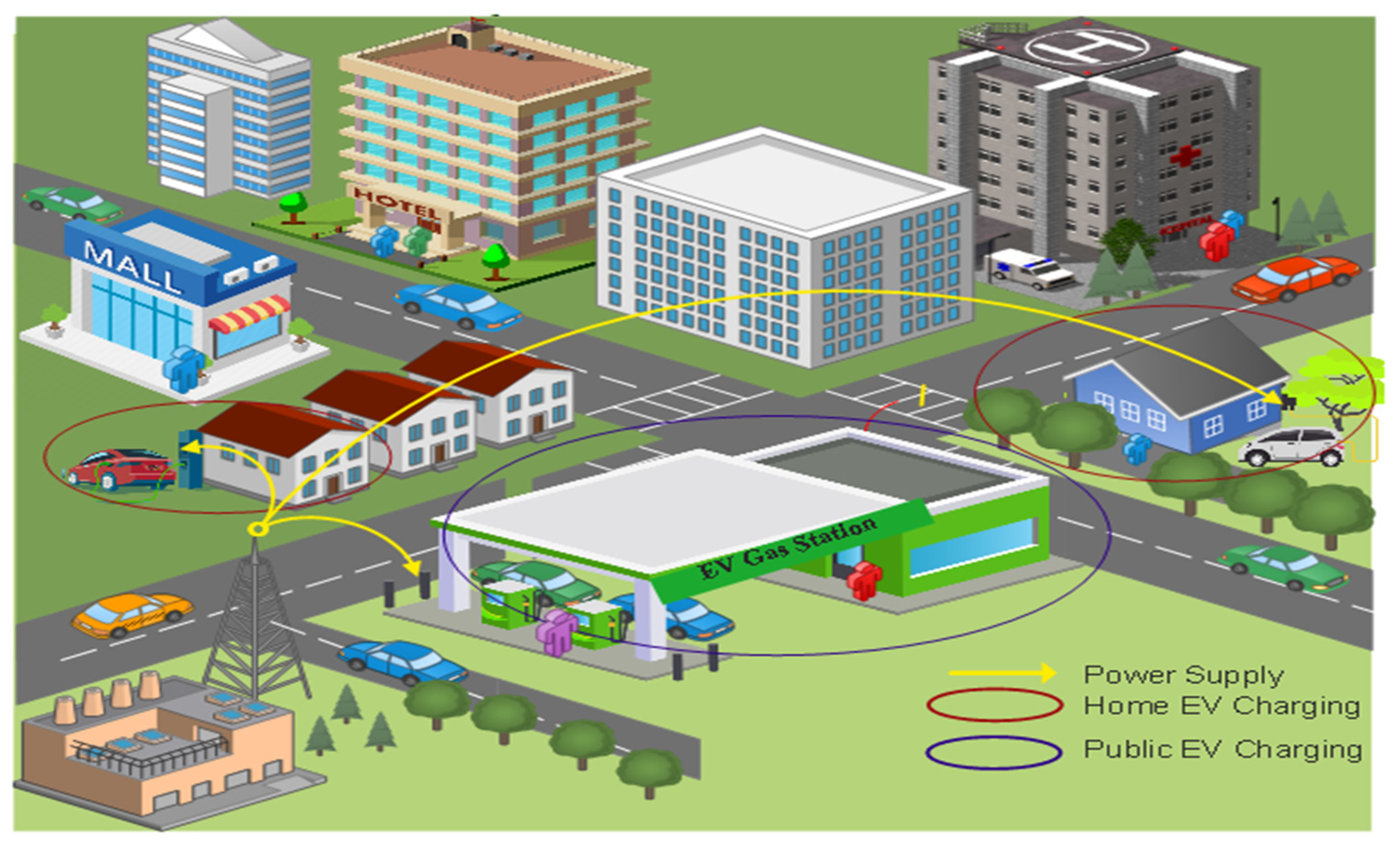
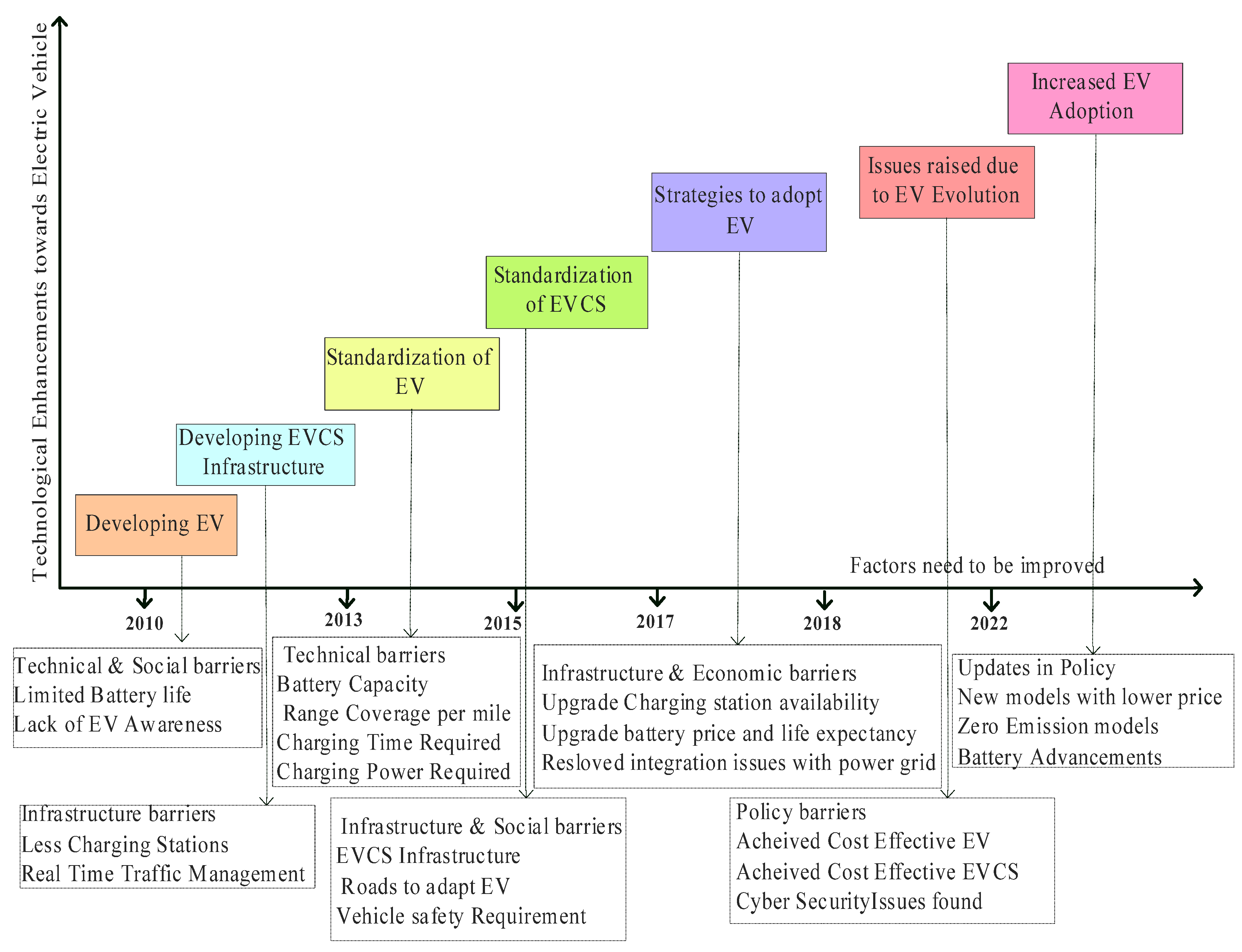
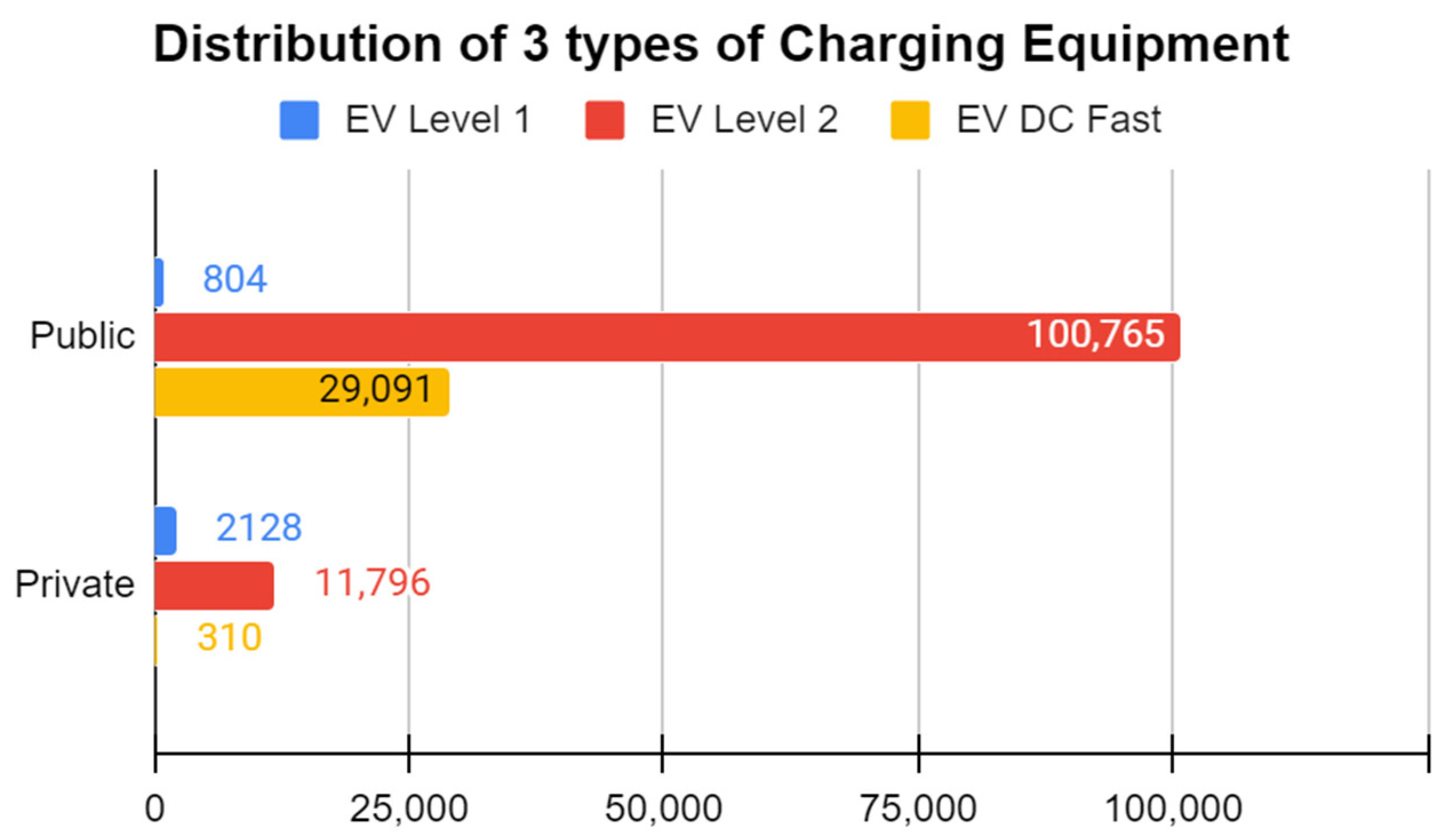


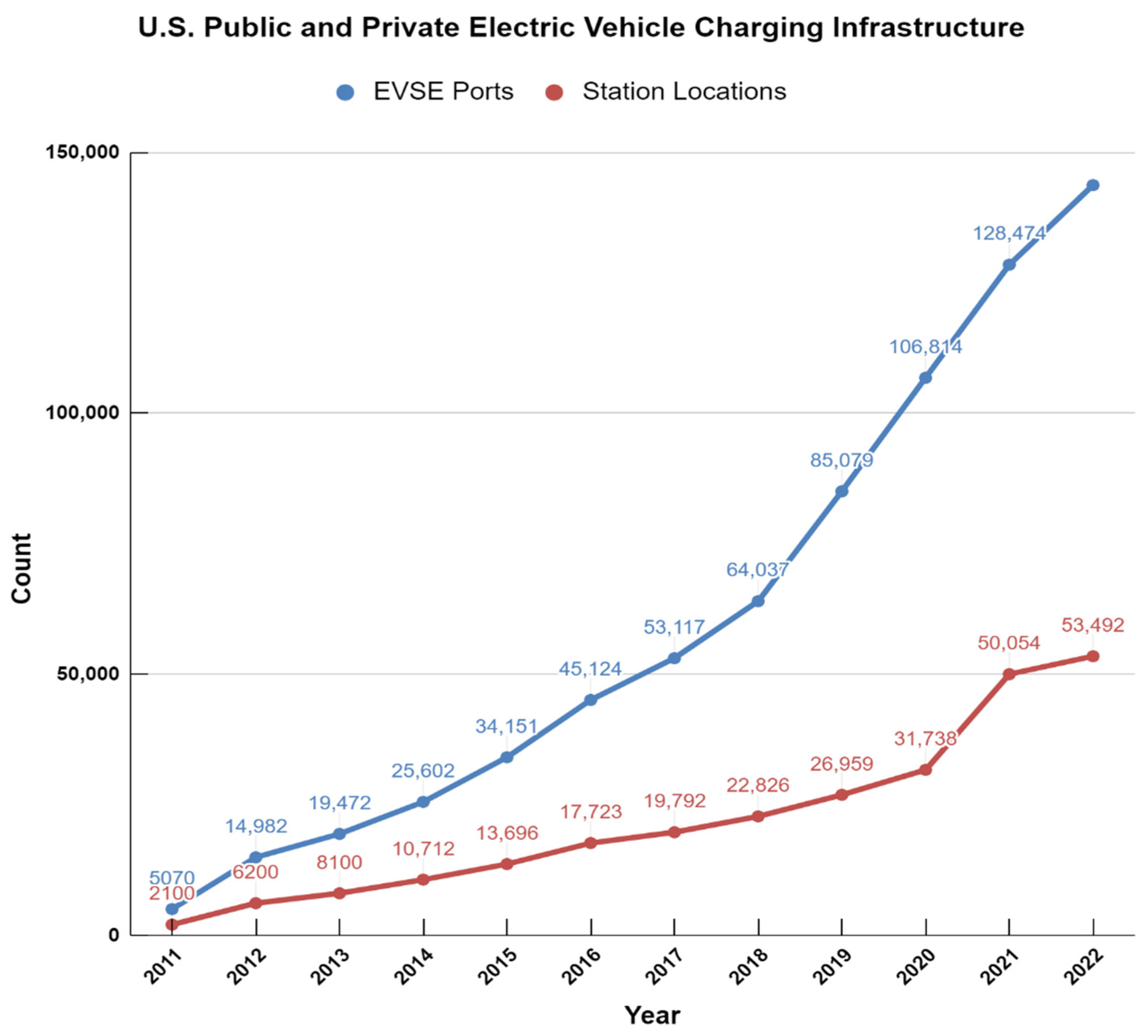
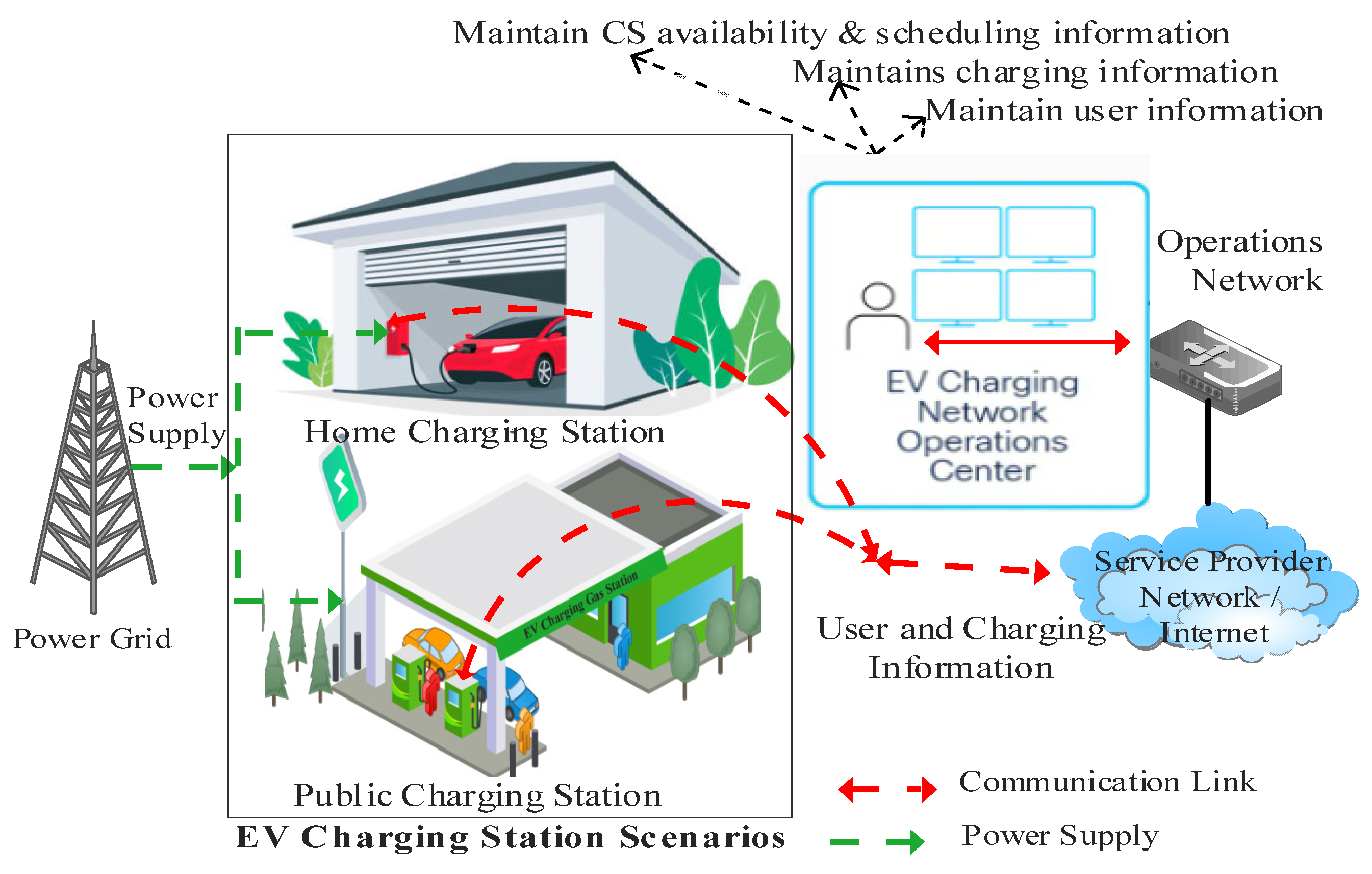
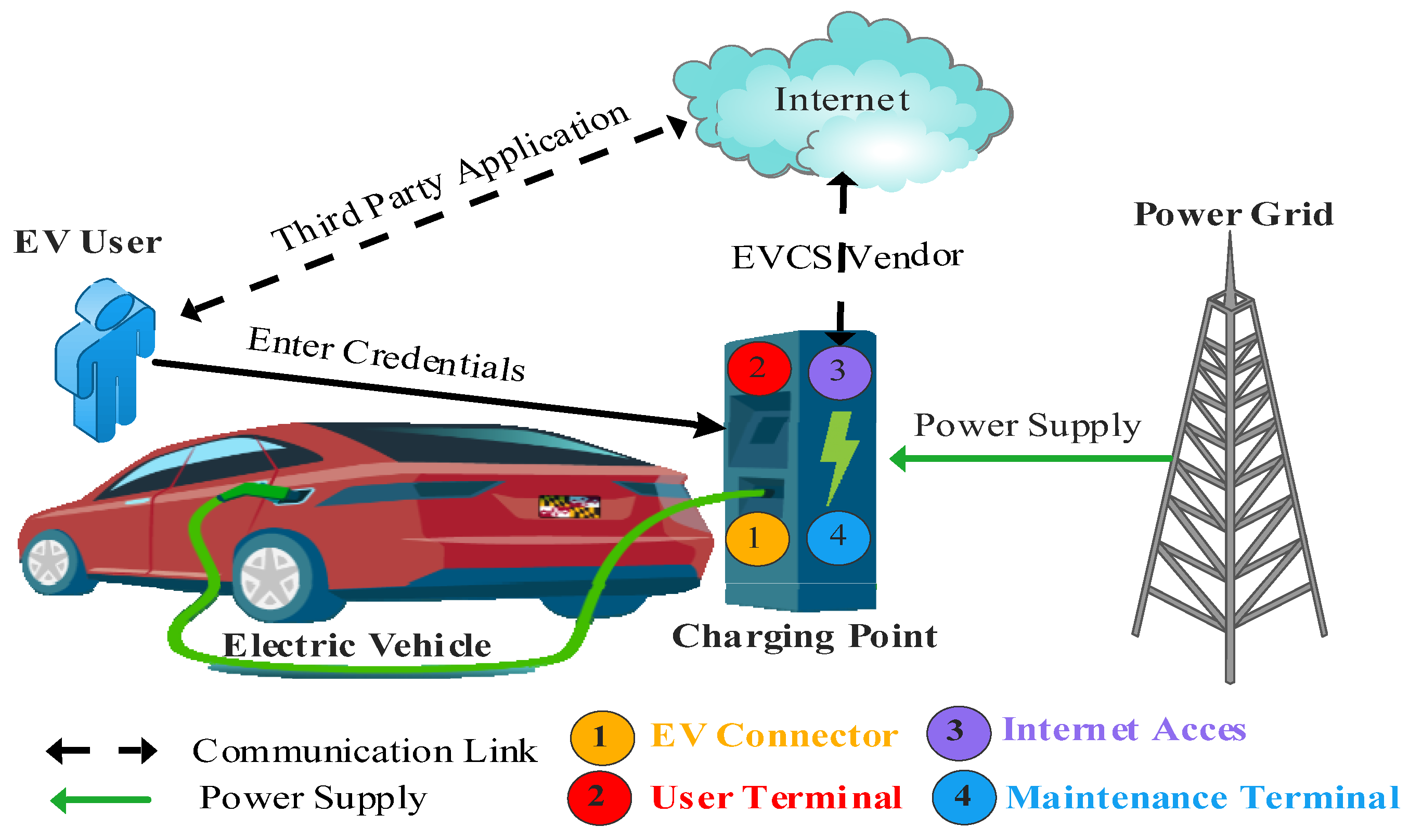


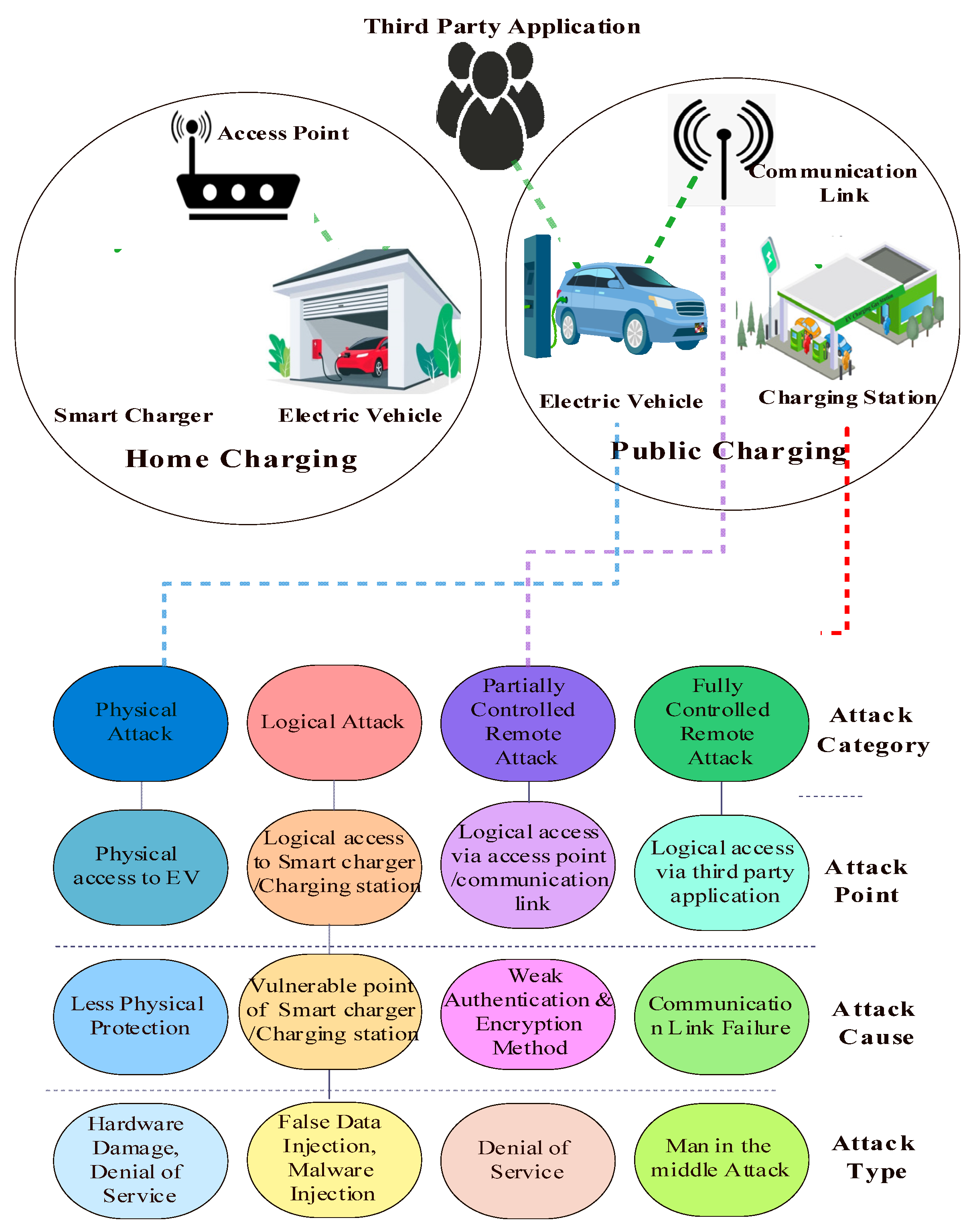
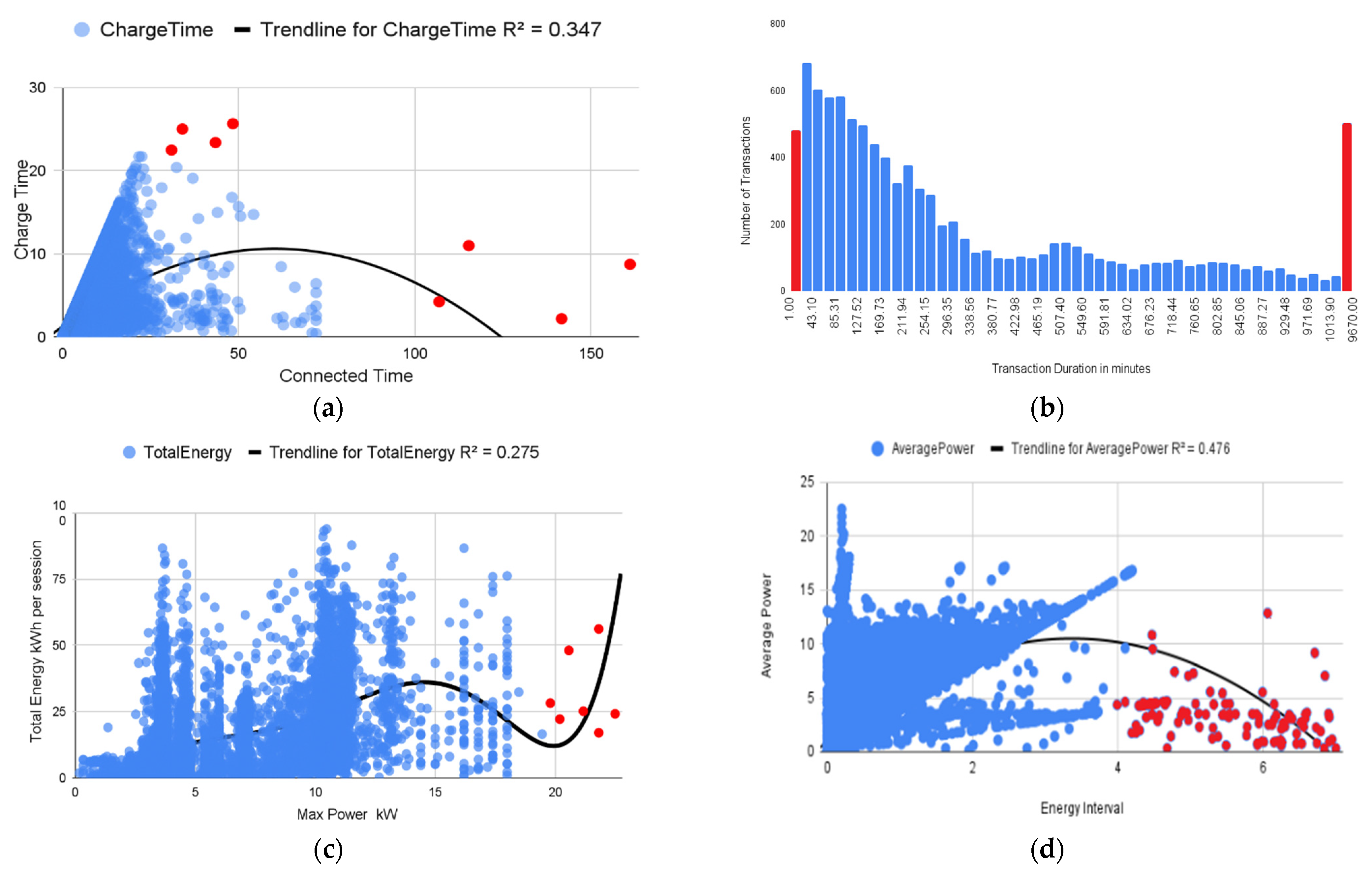
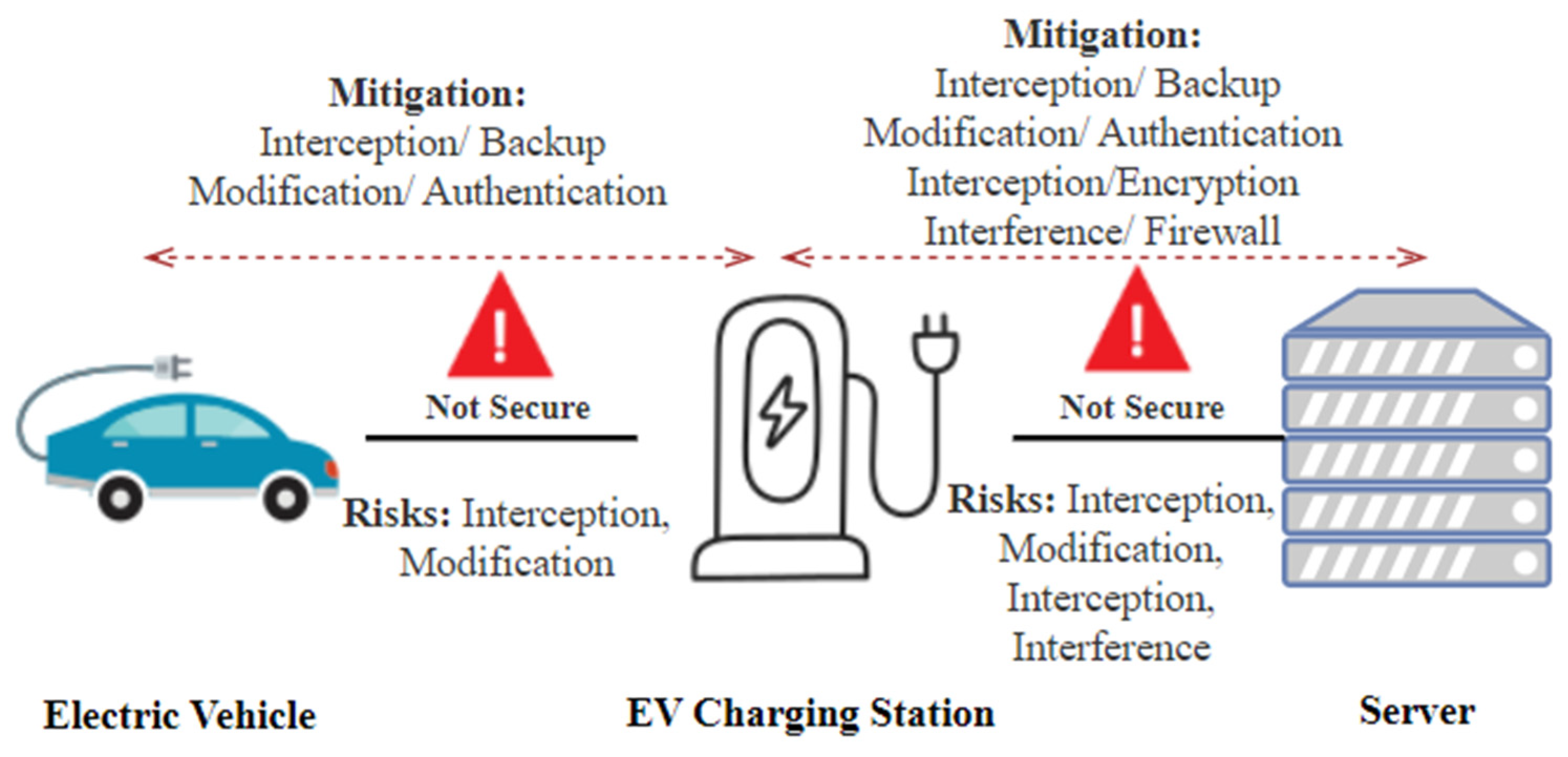

| Pros of Home Charging Infrastructure | Cons of Home Charging Infrastructure | Pros of Public Charging Infrastructure | Cons of Public Charging Infrastructure |
|---|---|---|---|
| More convenience, more savings, increased home value, less wear and tear, less susceptible to attack | Longer charging time, higher upfront Cost | No investment, more economical | Battery damage, longer waiting time, inconvenience in searching, more susceptible to attack |
Disclaimer/Publisher’s Note: The statements, opinions and data contained in all publications are solely those of the individual author(s) and contributor(s) and not of MDPI and/or the editor(s). MDPI and/or the editor(s) disclaim responsibility for any injury to people or property resulting from any ideas, methods, instructions or products referred to in the content. |
© 2023 by the authors. Licensee MDPI, Basel, Switzerland. This article is an open access article distributed under the terms and conditions of the Creative Commons Attribution (CC BY) license (https://creativecommons.org/licenses/by/4.0/).
Share and Cite
Hamdare, S.; Kaiwartya, O.; Aljaidi, M.; Jugran, M.; Cao, Y.; Kumar, S.; Mahmud, M.; Brown, D.; Lloret, J. Cybersecurity Risk Analysis of Electric Vehicles Charging Stations. Sensors 2023, 23, 6716. https://doi.org/10.3390/s23156716
Hamdare S, Kaiwartya O, Aljaidi M, Jugran M, Cao Y, Kumar S, Mahmud M, Brown D, Lloret J. Cybersecurity Risk Analysis of Electric Vehicles Charging Stations. Sensors. 2023; 23(15):6716. https://doi.org/10.3390/s23156716
Chicago/Turabian StyleHamdare, Safa, Omprakash Kaiwartya, Mohammad Aljaidi, Manish Jugran, Yue Cao, Sushil Kumar, Mufti Mahmud, David Brown, and Jaime Lloret. 2023. "Cybersecurity Risk Analysis of Electric Vehicles Charging Stations" Sensors 23, no. 15: 6716. https://doi.org/10.3390/s23156716
APA StyleHamdare, S., Kaiwartya, O., Aljaidi, M., Jugran, M., Cao, Y., Kumar, S., Mahmud, M., Brown, D., & Lloret, J. (2023). Cybersecurity Risk Analysis of Electric Vehicles Charging Stations. Sensors, 23(15), 6716. https://doi.org/10.3390/s23156716









